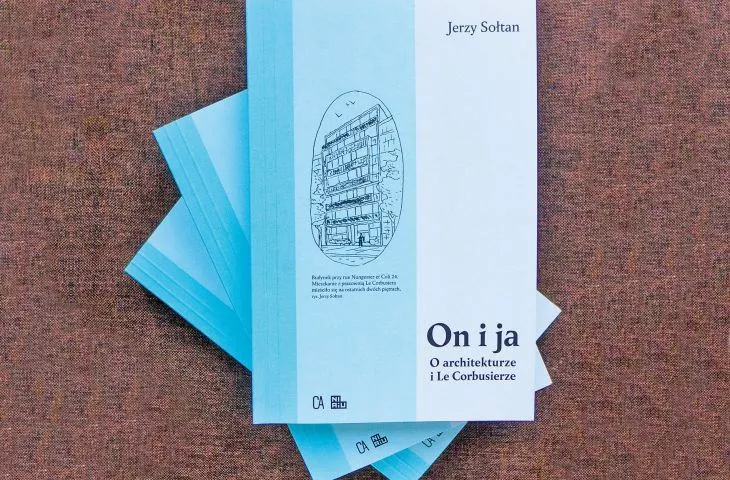The review appeared in A&B 5'2021
Hundreds of books and articles have been written about Le Corbusier, varying in their assessment of the figure of the "most influential architect of the 20th century." From hagiographic texts authored by devotees seduced by the talent of the "pope of modernism," to Nietzschean tragedy in the biography penned by Charles Jencks, to revisionists who denounced "Corbusier's raped design imagination. "1 The book "He and I" by Jerzy Soltan is different. It is a record of memories and reflections on not so much the architect and his views, but first of all the man.
He - Le Corbusier
Charles-Édouard Jeanneret-Gris was a complex and multidimensional figure. Jencks saw in him a constant struggle between the gentle sun god Apollo and the sensual, dark Dionysus2. Lech Niemojewski wrote in the 1930s that "ten critics will prove that Corbusier is inconsistent, the other ten will show that he writes something else and builds something else. "3 Nikolaus Pevsner emphasized the unique, individual character of his works4. Jakub Wujek regretted that Corbu "did not contradict his urbanist theories as forcefully as he did in the field of architecture. "5 In a word - there was no single Corbusier. So who is Charles-Édouard Jeanneret in Soltan's memoirs?
Corbusier is a revolutionary architect who is passionate about tradition and persistent in his search for the preform. An apologist for modernity who is surprisingly unmodern. A technocrat who wants to introduce a universally valid system of measurements and proportions, who ends his argument about Modulor with... a hand-drawn drawing of a banal flower. Il faut que ce soit beau. Let it be beautiful," Corbu emphasizes, thus going beyond the banal productivism of modernist "matchboxes. He leaves himself the right to make arbitrary decisions, and his attitude is close to Juliusz Żórawski, who, while condemning emotion-oriented architecture, was able to be guided by feelings in design, suggesting, as it were, that "there are no rules that cannot be broken for the sake of beauty "6.
Jerzy Soltan does not show one face of Corbusier. He reveals one view after another, as in his analysis of the reception of the facade of the Stein villa in Garches and the Parisian Church of the Invalides. At the end of the road, however, there is a monumental silhouette of the Swiss architect, and, no matter from which side we look at it, we are forced to see its greatness.
I - Jerzy Soltan
Reading Soltan's book prompted me to reread the interviews that Andrzej Bulanda conducted with the former Corbusier disciple in 1986-1989. "Conversations on Architecture" is an excellent complement to the content contained in "He and I."
Here is an architecture student at the Warsaw University of Technology discovering Le Corbusier, who (as he notes years later) "was not understood in Poland. He was too difficult. "7 After the defeat of the September campaign, he is sent to an oflag, from where he writes his first letter to the Master. The correspondence continues until liberation, when Soltan makes his way to Paris. On a July afternoon in 1945, he calls at an apartment in rue Nungesser et Coli. Corbusier opens it for him. Tiens, c'est Soltan, mais vous êtes trop grand (A, that's Soltan. But you're too tall) - these words mark the beginning of several years of cooperation and a friendship that lasted much longer.
The relationship between Soltan and Corbusier went beyond the traditional master-student relationship or the professional arrangement of boss and employee. It represented an intertwining of the two men's friendship, the admiration of an unknown architect from Poland for the luminary of world modernism, and the respect of the latter for his younger colleague.
In 1949, Soltan decides to return to his homeland. Despite emerging doubts and Jerzy Putrament's warnings, suggesting that the climate in Bierut's Poland is not conducive to the development of free thought, Soltan returns guided by "sentiment and obligations to Poland." In communist Poland, however, people with ties to the West are not welcome. Soltan, who initially became dean at the Interior Design Department of the Warsaw Academy of Fine Arts, loses his position. He manages to survive at the Academy thanks to the care extended to his former colleague Corbu by rector Marian Wnuk.
People's Poland is unwilling and unable to take advantage of Soltan's enormous potential. "The Man Who Didn't Build Poland" - the title of the documentary film dedicated to the figure of the architect, directed by Marcin Giżycki and Slawomir Grünberg, is an excellent, although extremely bitter, summary of his fate in his homeland.
Could the story of Jerzy Soltan, who eventually becomes a professor at Harvard after all, have turned out differently? How much of his fate was influenced by the political situation (we know that it was huge), and how much was determined by the fact that throughout his life, unable to free himself from the shadow of Le Corbusier, he carried his message, remaining an apostle of the news of l'espirit nouveau?
Modulor - three variants of the growth: the original (1945), in line with the growth of Jerzy Soltan (1946) and the revised one
drawing: Jerzy Soltan / Museum of the Academy of Fine Arts in Warsaw
Tracés régulateurs in the composition of the Stein villa in Garches
drawing: Jerzy Soltan / Museum of the Academy of Fine Arts in Warsaw
memories
At the time Jerzy Soltan wrote down his memoirs about the period he spent in Le Corbusier's Paris studio on rue de Sèvres, the world of architecture looked different from the first postwar years. The author saw the ideas of his master and friend being negated and rejected. He witnessed the architectural counter-revolution. He himself stated that he disliked postmodernism, as it was an expression of pessimism and desperation that supplanted the modernist belief in progress.
Perhaps this is the origin of the need to defend the person of the Master and his views, which is clearly felt both in direct argumentation and in the lack of criticism or revision of old beliefs. It is hard to believe that after several decades nothing would raise doubts or prompt critical reflection. Yet Soltan takes no such steps. Yes, he recalls situations when he disagreed with Corbu or noticed potential dangers. "Imitating without proper assimilation can end in disaster! - he writes about the design of the Notre-Dame-du-Haut chapel in Ronchamp. These situations do not disrupt the consistent image of the Master, who, although not infallible, all problems are due to a misunderstanding of his ideas. It was "others" who did not grasp Corbu's methods. They did not understand his way of doing things. They were unable to follow the meandering paths set by the mind of the brilliant architect.
However, it would be a mistake to treat Soltan's book as a monument to Jeanneret. The author is far from the attitude of Irena Krzywicka, who wrote that "Le Corbusier was a prophet and a revelation to us all. "8"He and I" is a description of the relationship with the Master and Friend (or perhaps Friend and Master?). A warm picture, exuding positive emotions. Perhaps, in fact, in places it can be a bit indiscriminate, but doesn't each of us create just such a picture of close people?
The chapel of Notre-Dame-du-Haut in Ronchamp, France
drawing: Jerzy Soltan / Museum of the Academy of Fine Arts in Warsaw
a lesson in architecture
Jerzy Soltan's book can be read on several levels. It is a record of the memoirs of a post-war designer, a representative of the generation that believed that modern architecture and urban planning would make the world a better place. It is a personal picture of Le Corbusier created not from the perspective of a researcher, but of a student and friend.
It contains a record of the design methods used by the most influential architect of the 20th century. It describes the idea of shaping the proportions of a solid, the essence of creating a program. Reveals the "kitchen" of the studio on rue de Sèvres.
"He and I" also shows a deeper truth about architecture, which is hidden behind the proportions of the Modulor, the points in the space of the Stein villa and the programming of the Unité d'habitation. This truth is hidden in an inconspicuous flower drawn by Corbusier, and says that architects are in fact incurable romantics who seek, above all, beauty. So let it be beautiful! Il faut que ce soit beau!
Błażej Ciarkowski
Illustrations provided courtesy of the Center for Architecture.
1. "SARP Seminar on the Architecture of Sacred Buildings, Kazimierz Dolny, November 20-21, 1982", Warsaw 1983, p. 45.
2. Ch. Jencks "Le Corbusier - the tragedy of modern architecture", Warsaw 1982
3. L. Niemojewski "Corbusier as a writer", "Architektura i Budownictwo" 1934, no. 4, p. 113
4. N. Pevsner "History of European architecture", Warsaw 1976, p. 420
5. J. Wujek "Myths and utopias of 20th century architecture", Warsaw 1986, p. 235
6. D. Juruś "Architecture seeking understanding", [in:] J. Żórawski "Selection of aesthetic writings", Krakow 2008, p. XX
7. J. Soltan "Conversations about architecture", Warsaw 1996, p. 40
8. I. Krzywicka "Confessions of a scorcher", Warsaw 1992, p. 100.




























